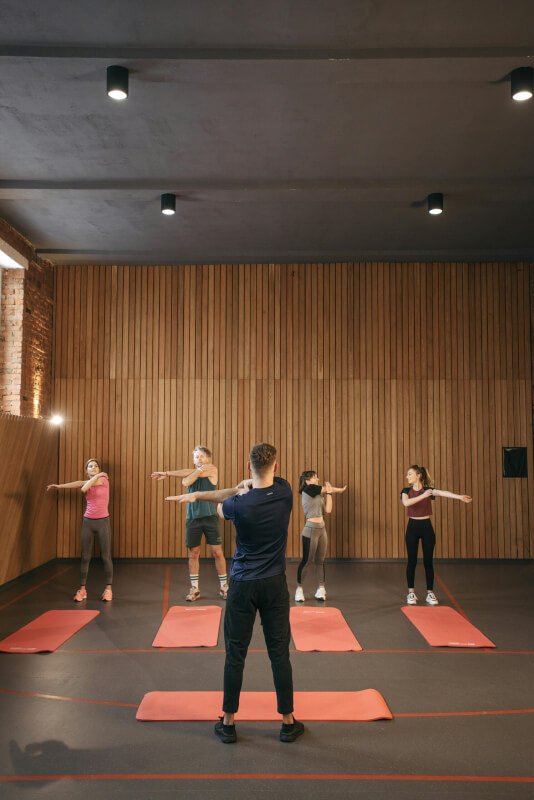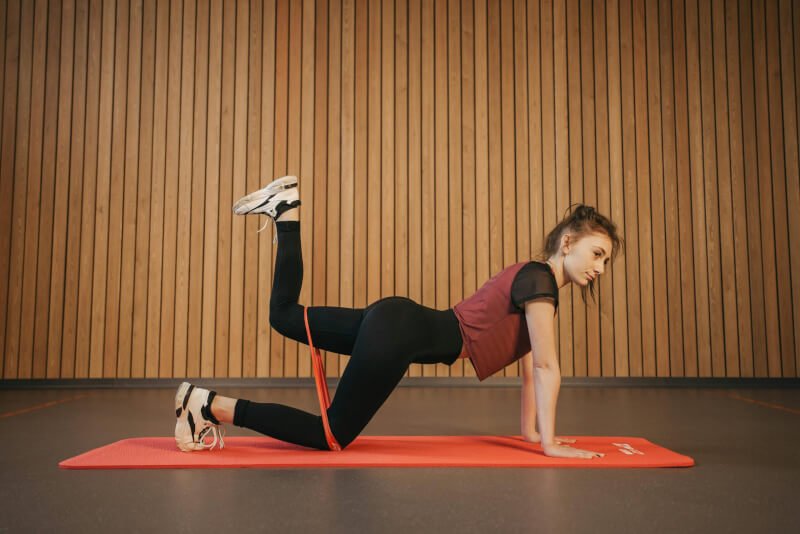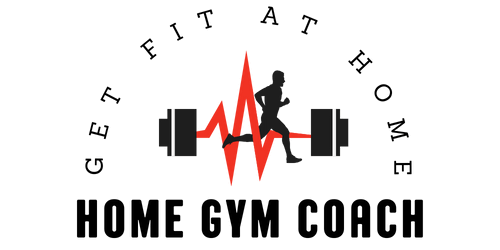Are you tired of feeling stiff and inflexible? Look no further! In this article, you will discover the key to unlocking a more flexible and nimble body through custom workout plans. Whether you are a beginner or an experienced athlete, these personalized exercises will help you achieve greater flexibility and mobility. Say goodbye to muscle tightness and hello to a more flexible you!

Creating a Custom Workout Plan
Assessing Current Flexibility Levels
When creating a custom workout plan to improve flexibility, it’s essential to start by assessing your current flexibility levels. This will allow you to understand your starting point and track your progress over time. You can assess your flexibility by performing various flexibility tests, such as the sit-and-reach test or the shoulder flexibility test. By knowing your current flexibility levels, you will be able to set realistic goals and tailor your workout plan accordingly.
Setting Goals for Improved Flexibility
Setting clear and achievable goals is crucial for any workout plan, including those focused on improving flexibility. As you set your goals, it’s important to be specific, measurable, attainable, relevant, and time-bound (SMART). For example, your goal might be to increase your hamstring flexibility by 2 inches within three months. Setting specific goals will help you stay motivated and track your progress effectively.
Identifying Areas of Focus
Once you have assessed your current flexibility levels and set your goals, the next step is to identify the areas of focus in your flexibility training. Determine which muscle groups or joints need the most improvement and target those areas in your workout plan. For example, if you struggle with tight hips, you may want to focus on exercises that improve hip flexibility specifically. By identifying your areas of focus, you can tailor your workout plan to address your specific needs.
Choosing the Right Flexibility Exercises
Static Stretching
Static stretching involves holding a stretch for a certain period without any movement. This type of stretching is commonly used to improve flexibility and increase muscle relaxation. Static stretches can be done both before and after your workout to help warm up or cool down the muscles. Examples of static stretches include the standing quad stretch, the seated forward bend, and the butterfly stretch.
Dynamic Stretching
Dynamic stretching involves moving different parts of your body through a full range of motion. Unlike static stretching, dynamic stretches are performed with controlled movements. They help warm up the muscles and increase blood flow while improving flexibility. Dynamic stretches can be incorporated into your pre-workout routine to prepare your body for the specific movements you’ll be doing during your workout. Examples of dynamic stretches include walking lunges, arm swings, and leg swings.
Active Isolated Stretching
Active isolated stretching (AIS) is a flexibility technique that focuses on specific muscle groups and joints. It involves stretching a muscle briefly and then releasing it, repeating the process several times. Each stretch is held for only 1-2 seconds, preventing the muscles from reflexively contracting. Active isolated stretching can help increase your range of motion and enhance overall flexibility. It is commonly used by athletes and can be incorporated into your workout plan to target specific areas of focus.
Incorporating Stretching into Your Routine
Warming Up
Warming up before any exercise or stretching routine is essential to prepare your body for physical activity. Warming up increases blood flow to the muscles and helps them become more flexible and pliable. Incorporate dynamic stretching exercises into your warm-up routine to mobilize and activate your muscles. By doing so, you’ll reduce the risk of injury during your workout and enhance the effectiveness of your flexibility training.
Cooling Down
Just as warming up is important, cooling down after a workout or stretching session is equally crucial. Cooling down involves performing static stretches to gradually relax the muscles after exercise. Cooling down helps prevent the buildup of lactic acid in the muscles, reduces muscle soreness, and aids in the recovery process. By incorporating static stretches in your cool-down routine, you allow your muscles to return to their normal resting length, promoting flexibility and preventing muscle tightness.
Stretching Frequency
To see significant improvements in flexibility, it’s important to incorporate regular stretching sessions into your workout plan. Aim for at least three stretching sessions per week, focusing on the areas you want to improve. If you have specific flexibility goals, consider dedicating more sessions to those target areas. Remember that consistency is key, and progress takes time. By being consistent with your stretching routine, you’ll gradually see improvements in your flexibility over time.
Sample Workout Plans
Beginner Level
For beginners looking to improve their flexibility, a sample workout plan could include a combination of static stretches and dynamic stretching exercises. Start with a brief warm-up consisting of five minutes of light cardio, such as brisk walking or cycling. Follow this with a series of dynamic stretches, targeting major muscle groups and joints. Finish the workout with a cooldown consisting of static stretches for each major muscle group, holding each stretch for 15-30 seconds.
Intermediate Level
Intermediate-level workout plans can be more intense and can include a variety of flexibility exercises. Begin with a warm-up that includes five to ten minutes of light cardio, such as jogging or jumping jacks. Proceed with dynamic stretching exercises that target specific areas of focus. Incorporate active isolated stretching to further enhance flexibility in those areas. Cool down with static stretches, holding each stretch for 20-30 seconds, focusing on major muscle groups and problem areas.
Advanced Level
Advanced-level workout plans for flexibility training can be more demanding and intense. Begin with a warm-up that includes ten minutes of moderate cardio, such as running or cycling. Incorporate dynamic stretching exercises that challenge your range of motion and flexibility. Utilize active isolated stretching to target specific areas of focus and improve overall flexibility. Cool down with static stretches, holding each stretch for 30-60 seconds, paying close attention to tight muscle groups and problem areas.

Progressive Overload for Flexibility
Increasing Duration and Intensity
Progressive overload is a principle commonly used in strength training but can also be applied to flexibility training. To continually improve your flexibility, you need to gradually increase the duration and intensity of your stretches over time. This can be done by gradually increasing the time you hold each stretch or by incorporating more challenging variations of the stretches you’re already performing. By progressively overloading your muscles and joints, you’ll continue to improve your flexibility.
Adding Resistance
Adding resistance to your flexibility exercises can further enhance your flexibility gains. Resistance can be added in the form of resistance bands, weights, or even your own body weight. For example, using a resistance band while performing seated hamstring stretches can provide an additional challenge and help you increase your hamstring flexibility. Gradually increase the resistance as you become more comfortable with the exercises to continue challenging your muscles and improve flexibility.
Using Props and Equipment
Certain props and equipment can aid in improving flexibility and making your workout more effective. For example, yoga blocks can be used to help support and stabilize your body during stretches, allowing you to maintain proper form and alignment. Foam rollers can be used for self-myofascial release, helping to release tension and tightness in the muscles. Additionally, stretching straps can assist in achieving deeper stretches and increased flexibility. Experiment with different props and equipment to find what works best for you and incorporate them into your routine.
Tracking Your Progress
Keeping a Flexibility Journal
Keeping a flexibility journal is a great way to track your progress and stay motivated. In your journal, record the exercises and stretches you perform in each workout session, along with any specific details such as duration and intensity. Additionally, note any improvements or changes you notice in your flexibility over time. By regularly reviewing your journal, you’ll be able to see how far you’ve come and identify any areas that may need adjustment or improvement in your workout plan.
Taking Measurements
In addition to keeping a journal, taking measurements of your flexibility can provide tangible evidence of your progress. Use a measuring tape or ruler to measure the range of motion in specific joints or muscle groups before starting your workout plan. Repeat the measurements periodically to see how your flexibility has improved. For example, if you’re working on hip flexibility, measure your hip flexion and extension before and after a designated time period. This objective data will help you evaluate the effectiveness of your workout plan and make any necessary adjustments.
Evaluating and Adjusting the Plan
Regularly evaluating and adjusting your workout plan is essential to ensure continued progress and avoid plateaus. As you track your progress and gather feedback from your body, reassess your goals and areas of focus. Consider whether you need to increase the duration or intensity of your stretches, incorporate new exercises, or modify your routine to target specific areas. By consistently evaluating your plan and making adjustments, you can optimize your flexibility training and continue to improve your flexibility over time.

Precautions and Safety Tips
Listening to Your Body
When engaging in flexibility training, it’s essential to listen to your body and avoid pushing yourself beyond your limits. While it’s normal to experience mild discomfort during stretching, never force or push your body into painful positions. Stretching should feel challenging but not painful. If you feel any sharp or intense pain, stop immediately and consult a healthcare professional. Pay attention to your body’s signals and adjust your routine accordingly to avoid potential injuries.
Avoiding Overstretching
While it may be tempting to strive for maximum flexibility, overstretching can lead to injuries and setbacks in your workout plan. Always stretch within your comfortable range of motion and avoid bouncing or jerking movements. Overstretching can result in muscle strains, ligament sprains, or joint instability. Instead, focus on slow, controlled movements and gradual progress in your flexibility training. Remember, flexibility is a journey, and consistent, steady progress will yield the best results.
Working with a Professional
If you’re new to flexibility training or have specific health concerns or limitations, it’s advisable to work with a professional, such as a certified personal trainer, physical therapist, or yoga instructor. These professionals can assess your specific needs, provide personalized guidance, and ensure that you’re performing stretches and exercises with proper form and technique. They can also help monitor your progress and make any necessary adjustments to your workout plan to maximize your flexibility gains while minimizing the risk of injuries.
Flexibility Training for Specific Activities
Yoga
Yoga is a discipline that combines physical postures, breathing exercises, and meditation to improve flexibility, strength, and overall well-being. A dedicated yoga practice can significantly enhance flexibility in various muscle groups, including the hips, hamstrings, shoulders, and spine. Incorporating yoga into your custom workout plan can provide a holistic approach to flexibility training while also promoting relaxation and stress reduction.
Dancing
Flexibility is a vital component of many dance styles, as it allows dancers to perform a wide range of movements with grace and fluidity. Dance-focused flexibility training often includes dynamic stretching exercises, such as leg swings and hip circles, to warm up the muscles and increase mobility. Additionally, static stretching is incorporated to improve flexibility in specific muscle groups relevant to the chosen dance style. By incorporating dance-specific flexibility exercises into your workout plan, you can enhance your dancing abilities and prevent dance-related injuries.
Gymnastics
Gymnastics requires exceptional flexibility to perform intricate and acrobatic movements. Flexibility training for gymnastics typically includes a combination of static and dynamic stretching exercises. Static stretches are used to increase flexibility in specific muscle groups relevant to various gymnastics disciplines, such as the splits for artistic gymnastics. Dynamic stretches are incorporated to warm up and prepare the body for the explosive movements involved in gymnastics routines. By incorporating gymnastics-specific flexibility exercises into your workout plan, you can improve your overall flexibility and excel in this demanding sport.

Incorporating Stretching in Other Workouts
Strength Training
Integrating stretching into your strength training workouts is essential for maintaining a balance between strength and flexibility. Prioritize dynamic stretching exercises during your warm-up to activate and mobilize the specific muscle groups you’ll be targeting during the strength training session. After your strength training exercises, include static stretches for those same muscle groups to promote flexibility and prevent muscle tightness. By combining strength training with flexibility training, you’ll enhance your overall physical fitness and reduce the risk of injuries.
Cardiovascular Exercise
Cardiovascular exercises, such as running or cycling, primarily focus on improving cardiovascular fitness and burning calories. However, incorporating flexibility training alongside your cardiovascular workouts can provide additional benefits. Begin your cardio workouts with dynamic stretching exercises to warm up the muscles and prepare your body for the activity. After your cardio session, incorporate static stretches for major muscle groups to prevent muscle soreness and maintain or improve flexibility.
Pilates
Pilates is a low-impact exercise method that emphasizes core strength, flexibility, and body awareness. Pilates exercises often incorporate controlled movements and focused breathing to improve strength and stability, while also promoting flexibility. Flexibility training in Pilates typically involves a combination of dynamic stretching exercises and controlled elongation of the muscles during various movements. By incorporating Pilates into your workout routine, you can improve core strength, overall flexibility, and body alignment.
Benefits of Improved Flexibility
Enhanced Athletic Performance
Improved flexibility contributes to enhanced athletic performance in various sports and physical activities. Increased flexibility allows for greater range of motion in joints, enabling athletes to perform movements with more power and precision. Additionally, improved flexibility can reduce the risk of muscle imbalances and injuries, as flexible muscles are less prone to strains or tears. Whether you’re a professional athlete or simply enjoy recreational sports, incorporating flexibility training into your workout plan can significantly enhance your athletic performance.
Reduced Risk of Injuries
One of the key benefits of flexibility training is the reduced risk of injuries. By increasing your range of motion and flexibility, you improve joint mobility and minimize the strain placed on muscles and connective tissues during physical activities. With increased flexibility, your body can better absorb impact and maintain stability, reducing the likelihood of sprains, strains, or muscle imbalances. Whether you’re engaged in high-impact sports or simply performing everyday activities, having good flexibility can help prevent injuries and keep you active and injury-free.
Improved Posture and Alignment
Flexibility training can greatly improve posture and alignment, leading to better overall body mechanics and decreased strain on joints and muscles. Tight muscles can contribute to poor posture, as they can pull the body out of optimal alignment. By incorporating flexibility exercises into your routine, you can lengthen and release tight muscles, allowing the body to naturally realign itself. This improved posture can relieve tension in the neck, shoulders, and back and promote better overall body mechanics, reducing the risk of chronic pain and injuries.
In conclusion, creating a custom workout plan for improving flexibility is essential for anyone looking to enhance athletic performance, reduce the risk of injuries, and improve posture and alignment. By assessing your current flexibility levels, setting goals, and identifying areas of focus, you can tailor your workout plan to meet your specific needs. Choosing the right flexibility exercises, incorporating stretching into your routine, and tracking your progress will further optimize your flexibility training. By utilizing progressive overload techniques, taking precautions, and working with professionals if needed, you can ensure a safe and effective flexibility training experience. Whether you’re a beginner or an advanced athlete, integrating flexibility training into your workout plan will bring about numerous benefits and contribute to your overall health and well-being. So start today and embark on your journey to improved flexibility!


